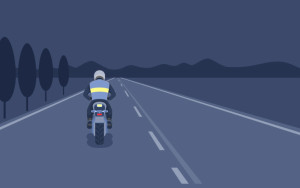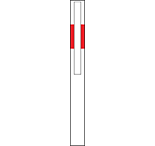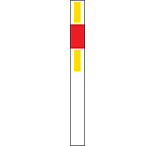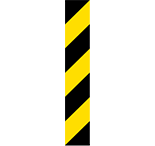You must turn on your vehicle's headlights:
You must dip your vehicle’s headlight:

Dipping the headlight for an oncoming vehicle

Dipping the headlight when following another vehicle
At other times, use your high beam so you can see further.
You must ride at a safe speed. This means that:
It’s important to wear clothing and equipment that help you be seen at night.
It's a good idea to wear reflective clothing or put reflective tape on your clothing.
It’s also a good idea to have reflectors and/or reflective tape on the side of your motorcycle.

Wearing reflective vest
Riding at night is more dangerous than riding during the day. To improve your safety on the road at night:
ImportantWearing a scratched face-shield is dangerous, especially at night or when it's wet. It'll pick up reflective glare from oncoming vehicles. Replace a scratched face-shield immediately. |
Many roads have reflectors and guide posts to help you read the road at night. Here are some examples of these.

Left side of the road marker post

Right side of the road marker post indicating left-hand bend

Left side of bridge

Right side of bridge

Left side of road

Centre line

No passing

Fire hydrant
ImportantMost road signs are highly reflective, your light shining on them at night may make you can see further than you really can. Make sure you ride more slowly and carefully at night, particularly on unfamiliar roads. |